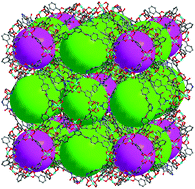The high porosity, excellent water stability and optimized supramolecular host–guest interactions of MOFs are the three key factors for their potential practical applications in many important areas including gas storage/separation, catalysis and so on. In this study, we designed and constructed a highly porous (3, 36)-connected txt-type acylamide-functionalized metal–organic framework (HNUST-8) from a pyridine-based acylamide-linking diisophthalate and dicopper(II)-paddlewheel clusters. Interestingly, HNUST-8 possesses an exceptionally water-stable framework with a high BET surface area of about 2800 m2 g−1. At 298 K, HNUST-8 exhibits a high excess CO2 uptake of 19.7 mmol g−1 at 40 bar, an excellent total CH4 storage capacity of 223 cm3(STP) cm−3 with a large working capacity of 178 cm3(STP) cm−3 at 80 bar, as well as highly efficient CO2/CH4 and CO2/N2 separation under dynamic conditions at 1 bar. Moreover, with the Lewis acidic open copper(II) sites and Lewis basic acylamide groups integrated into the framework, HNUST-8 demonstrates efficient catalytic activity as an acid–base cooperative catalyst in a tandem one-pot deacetalization–Knoevenagel condensation reaction.

